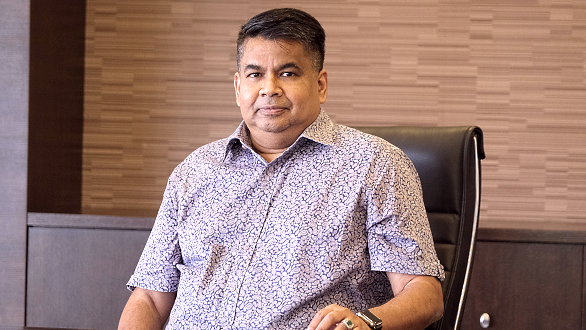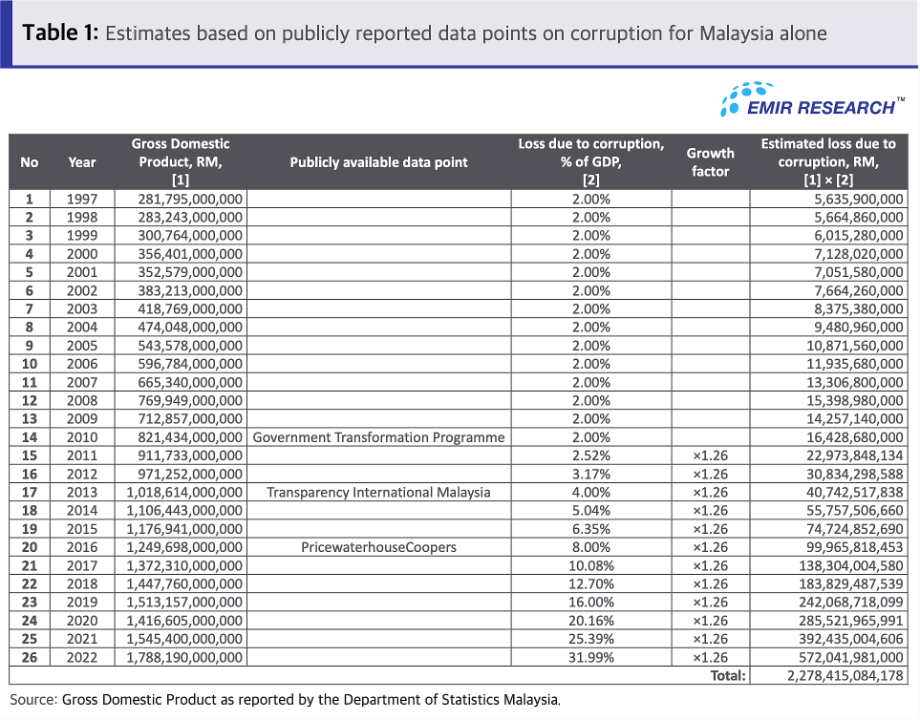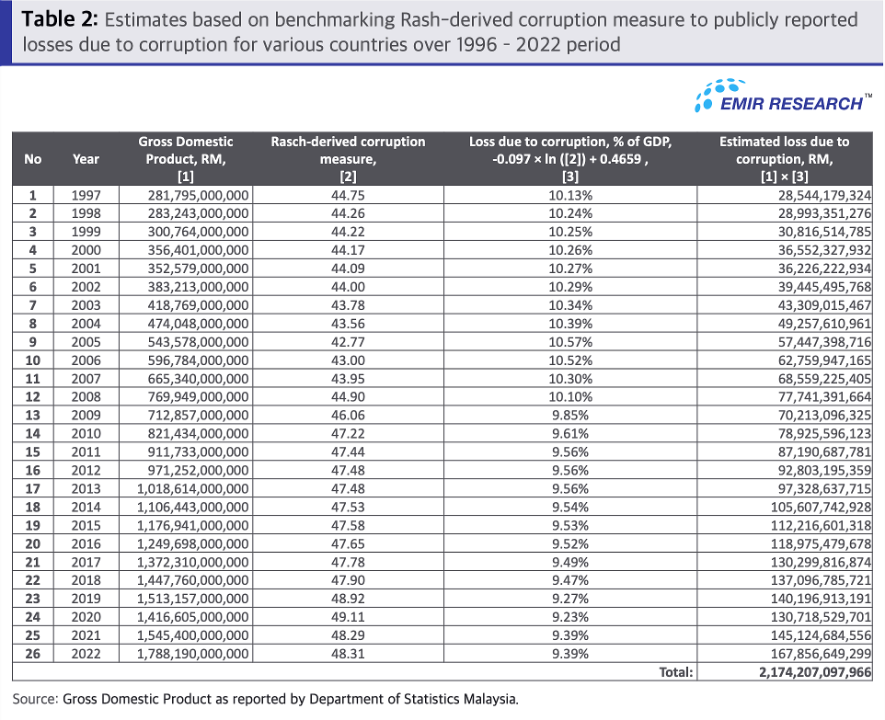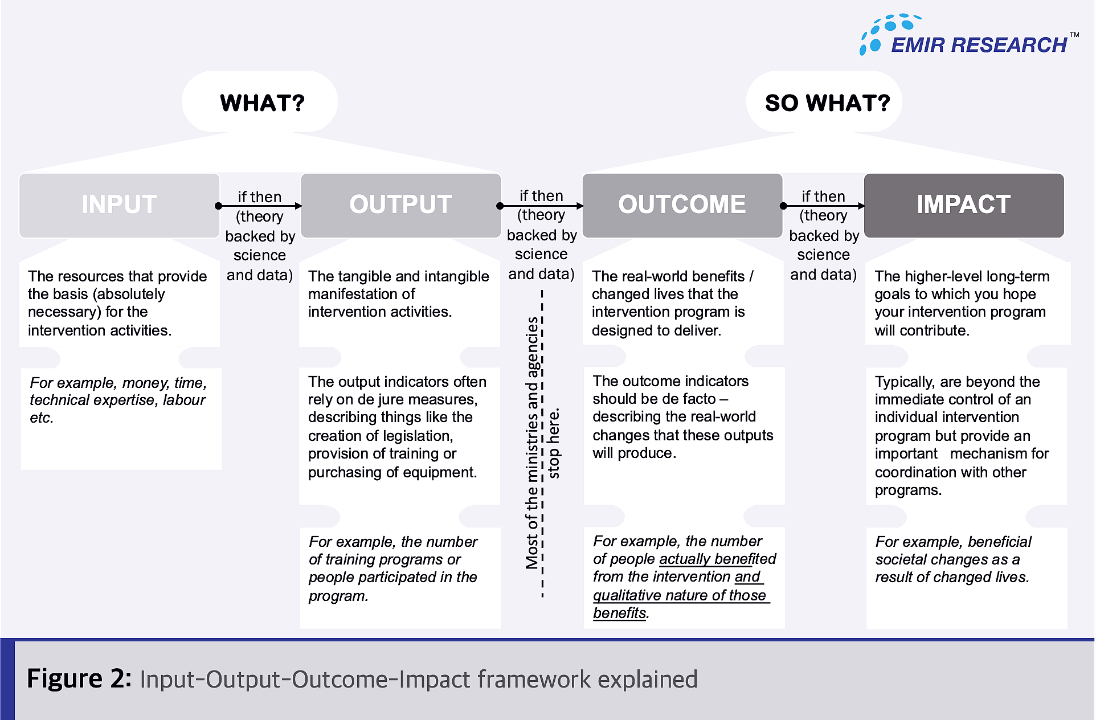
The recent publication by EMIR Research on the estimated losses due to corruption in the Malaysian economy has sparked significant public attention, which is a positive development.
When corruption reaches alarming levels, it must prompt public outrage, mature critical reflection and credible corrective action instead of quick and blind denial or populistic rhetoric with an eye for political posturing.
EMIR Research intends to provide additional clarification for an easier understanding of the research methodology adopted amidst some limited noises devoid of research methodology knowledge.
To be clear on this one more time, EMIR Research has not claimed any finality to the figures and, on the contrary, emphasized that this is a rigorous research exercise based on the best available research methods and publicly reported data points (local and global) to derive some reasonable and, in fact, frugally conservative estimates to one of the most daunting numbers — economic loss to corruption and leakages by a nation.
Notably, the estimates were explicitly not limited to the losses due to corruption and leakages by the public service.
Instead, the estimates were to the total monetary loss (across the sectors) due to corruption and leakages at every level in the economy which many countries at different times attempted to estimate as a percentage of their Gross Domestic Product (GDP).
Therefore, comparing the estimated figure with the government’s budgetary numbers, obviously, is not only ignorant but irrelevant.
In its attempt to estimate the corruption losses, EMIR Research has used two different methodologies.
Interestingly, both methodologies yield approximately similar results.
As the first approach, EMIR Research used publicly reported estimates for the national economic loss due to corruption expressed as a percentage of GDP, specifically in Malaysia by various authorities while trying to reconstruct the long-term trend over 26 years (Table 1, for details, refer to Malaysian Monetary Loss to Corruption and Leakages – RM4.5 Trillion over 26 years).

As an alternative — a scientific and rigorous — method, EMIR Research first used the Rasch modelling technique to create a linear measure for the level of corruption in various countries from 1996 to 2022 (the time frame based solely based on the availability of the data), which was then benchmarked against publicly reported estimates of losses associated with corruption as a percentage of GDP for 65 countries within the same period.
Rasch technique is specifically developed to derive linear measures for unobservable phenomena in the social sciences, such as, for example, perceived level of corruption, that, in reality, might be a non-linear variable — meaning assuming equal distances (like on an ordinal scale) between the perceived levels of intensity of those phenomena would be a massive leap of hope.
Therefore, using this technique EMIR Research combined various globally acknowledged indicators into a composite measure of corruption (some of which are explicitly expressed on an ordinal scale) which was also done in order not to rely on a single source of the estimate for the level of corruption in a given country.
Once the composite measure of corruption level for various countries from 1996 to 2022, given the data availability for the global indicators of corruption (refer to Figure 1 for the breakdown of the global indicators used), was calculated, it was then plotted against the publicly available data points for various countries, including Malaysia, for the national economic loss due to corruption in monetary terms expressed as a percentage of GDP (Figure 1).

The reported estimates for corruption cost to the economy covered the reports by various governments, think tanks, national anti-corruption agencies, Transparency International, World Bank, United Nations etc.
Understandably, some of these estimates might be understated/overstated.
Nevertheless, the regressed relationship between the derived Rasch measure and corruption cost to the economy as a percentage of GDP (blue line in Figure 1) captures something of an essence, given the significant percentage of variation explained.
Next, the derived regression equation (Figure 1) was used to estimate the corruption cost as a percentage of GDP based on the calculated Rasch measure of corruption in Malaysia over the available years (Table 2).

The two calculation methods (Table 1 and Table 2) produce very close results pointing to an estimated direct monetary loss to the Malaysian economy due to corruption of about RM2.2 trillion – RM2.3 trillion (RM2.25 trillion on average between the two methods) over the last 26 years.
To arrive at the eventual figure of RM4.5 trillion, EMIR Research did not add the totals from Table 1 and Table 2, as some “DJ scholars” might erroneously interpret.
Instead, EMIR Research brought in the economic concept of the multiplier effect for every cent injected into the economy, whether by the public or the private sector.
Every cent injected productively (based on real economic need/opportunity and merit) is bound to create wealth rippled multiple times through the economy, benefiting many.
These multipliers are always greater than one! Therefore, taking a multiplier of at least 1 (at least RM1 additional opportunity cost for every RM1 in direct monetary losses due to corruption), we can arrive at RM2.25 trillion × 2 = RM4.5 trillion, as a frugally conservative estimate of the total (direct + opportunity) economic cost of corruption to Malaysia society.
In the context of the Malaysian economy, the lost multiplier effect might be substantial due to the well-known propensity to “speed-to-spend”, especially among the public sector and not forgetting that Malaysia is among those with the highest percentage of Government/State Linked Companies and Institutions in the economy.
Speed-to-spend means when the budget (inputs) is given it must be spent quickly with some random outputs not necessarily linked to real outcomes and inter-generational impacts for the nation.
EMIR Research has emphasized multiple times that the only way to stem this “input-output only” culture is to institutionalize the Input-Output-Outcome-Impact framework at every level of decision-making and policy planning — from budget planning to budget execution (refer to EMIR Research’s earlier policy recommendations: Recalibrating national budget: eradicating leakages and corruption and Transforming Malaysia from third- to first-world country).
In brief, the IOOI framework is logical and robust reasoning (solely based on data, science and economics) of the entire causal path from inputs (finite resources/capitals) to outputs (tangible and intangible manifestation of intervention activities) to outcomes (real-world benefits/changed lives) and finally to impacts (higher-level intergenerational goals, if we speak in the context of a nation).
Importantly, each level comes with a set of metrics to track the progress of transforming inputs into outcomes and impacts (Figure 2).

In other words, when policymakers embark on an initiative, they must convince us, the public, that there is a solid basis in the form of empirical evidence and an established body of scientific knowledge to believe that spinning out an N number of resources on specific outputs will result in the desired outcomes and inter-generational impacts.
This is how we can ensure that every cent spent in our economy can have the right multiplier effect benefiting the MANY.
Given the enormity of the estimated economic loss due to corruption and leakages, it is logical to call for a comprehensive investigation aiming to recover as much money lost as possible.
Hence, the response by Prime Minister Anwar Ibrahim was spot on when he requested all the relevant government and enforcement agencies to do their best to recover the massive loot.
Emir Research would like to suggest the establishment of the Truth, Recovery and Amnesty Commission (TRAC) to diligently track and recover the monies so needed for the development of the nation and the people.
Modeled after the South African Truth and Reconciliation Commission, TRAC aims to bring about an effective closure of the painful and tearful decades of corruption in Malaysia (instead of the apartheid regime in the South African context).
Through TRAC, those who voluntarily return the monies, holiday mansions, movable and/or immovable assets etc. can be accorded some form of amnesty from prosecution with some restriction from participating and/or being appointed in public office.
For those who choose to go through the investigation and prosecution stage and are eventually found guilty of corruption must be brought to justice while given an option for amnesty upon returning the misappropriated assets.
Given the enormity of accumulated losses (EMIR Research has emphasized that estimates are frugally conservative) the recovered funds would be a great source of government revenues to consolidate our huge budget deficit and recalibrate it for productive use.
Of course, those with an eye for political optics would probably bring in the ethnicity trump card argument again that such an intervention may disadvantage a certain race.
However, the lies that have been told for decades to Malay and rural communities (the main grip hold of the then-ruling political super elites) are no longer possible to hide.
At least accumulated data shows very clearly how Malay and rural community economic conditions only deteriorated over the previous decades while the Bumiputera in the top income group (the top 1% and the 10%) benefited the most from economic growth (for statistical evidence and research sources, refer to Ruthless colonization Mat Kilau could not even imagine from July 25, 2022).
All in all, it is good that such research has sparked intense public debate given the enormity of its impact on the people and the nation. What more with such a massive estimated economic loss due to corruption and leakages.
Local universities, public and private, can and must initiate more deep-dive research on ascertaining the economic loss of the nation due to corruption and leakages.
Further, it can also research why such practices occur, how to stop them and how to recover the loot, through legal pathways though that can be excruciatingly long.
Additional research and insights, albeit possibly differing methodologies will no doubt enrich and embellish the discourse on addressing the corruption and leakages in our economy and the lessons for future generations.
Perhaps, as suggested, the establishment of TRAC helmed by individuals with impeccable skills, knowledge, abilities, experience, and integrity, can help fast-track and recover monies lost due to corruption and leakages over the years to be used to revive and rechart the Malaysian economy for the MANY and ALL.
This time, stringent use of the IOOI model, as explained earlier, from budget planning to budget execution and budget continuous tracking must be done. This will ensure the problem of corruption and leakages can be minimized. This work must start now.
(Dr. Rais Hussin is the president and chief executive officer of EMIR Research, a think tank focused on strategic policy recommendations based on rigorous research.)
ADVERTISEMENT
ADVERTISEMENT




































